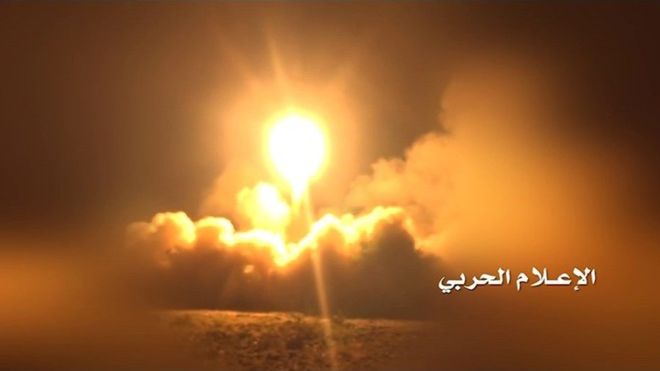
Iran-aligned Yemeni Houthi rebels have struck a power station in Saudi Arabia’s southern province of Jizan with a cruise missile, according to reports by the group’s Al Masirah TV channel.
Al Masirah said the reported attack took place in al-Shuqaiq city late on Wednesday evening. There was no immediate confirmation of the incident from the Saudi authorities.
On Thursday, White House officials confirmed US President Donald Trump had been briefed about an alleged strike on the kingdom’s “critical infrastructure”, without giving details of possible damage or casualties.
“We are closely monitoring the situation and continuing to consult with our partners and allies,” White House spokeswoman Sarah Sanders said in a statement.
Pentagon spokeswoman Navy Commander Rebecca Rebarich meanwhile said such attacks were “a significant cause for concern and [put] innocent lives at risk”.
‘No end in sight’
The Houthis have stepped up missile and drone attacks in Saudi Arabia in recent weeks amid rising tensions throughout the Middle East fuelled by a bitter standoff between Iran and the United States, which is allied to several Gulf Arab states, including Saudi Arabia.
Last week, a missile attack on Saudi Arabia’s southern Abha airport allegedly carried out by the rebel group left 26 civilians wounded.
Several other recent drone and missile attacks targeting other southern regions of the kingdom, including Khamis Mushait and Jizan, were intercepted by Saudi forces.
Al Jazeera’s Mohammed al-Attab, reporting from the Yemeni capital Sanaa, said there appeared to be “no end in sight” for attacks and reprisals between Saudi Arabia and the Houthis.
“The conflict is escalating … and according to the Houthi’s military spokesperson, the coming days will witness more surprises for Saudi Arabia, especially via reprisal attacks by cruise missiles and drone operations,” al-Attab said.
The Houthis have been at war with a Saudi-UAE led military coalition in Yemen since 2015, when the latter launched an intervention in the form of a massive air campaign aimed at reinstalling the internationally-recognised government of President Abd-Rabbu Mansour Hadi, who was earlier toppled by the Houthis.
Since then, the conflict has killed at least 10,000 people, according to the United Nations, while monitoring group Armed Conflict Location and Event Data Project (ACLED) on Wednesday said 91,600 people have been killed so far.
The war has unleashed what the UN describes as the world’s worst humanitarian crisis, with more than 24 million Yemenis – more than two-thirds of the population – deemed to be in need of aid.
Regional tensions rise
Amid the unrest in Yemen, friction has also ratcheted up across the wider region in recent weeks, with Washington and Riyadh blaming Tehran for a spate of attacks on critical oil-related assets and infrastructure, including two tankers in the Gulf of Oman and four ships off the United Arab Emirates (UAE).
Both incidents took place near the Strait of Hormuz, a major conduit for global oil supplies. Iran has denied responsibility for the attacks.
In the latest flashpoint on Thursday, Iran’s elite Revolutionary Guard force said it shot down a US “spy drone” over its territory, according to Iranian state television reports.
An anonymous US official later told news agencies that a US naval drone was downed over international airspace.
In moves it said were aimed at countering Iranian threats, Washington recently deployed forces including aircraft carriers, B-52 bombers and additional troops to the Middle East.
Despite the rising tensions, the US, Iran and Saudi Arabia have all said they do not want war to breakout in the region.
However, Washington has vowed to continue to pursue its “maximum pressure” campaign against Tehran that was rolled out after US President Donald Trump’s decision in May 2018 to withdraw from a landmark nuclear deal brokered between Iran and several other world powers, kickstarting increasingly fractious relations.


